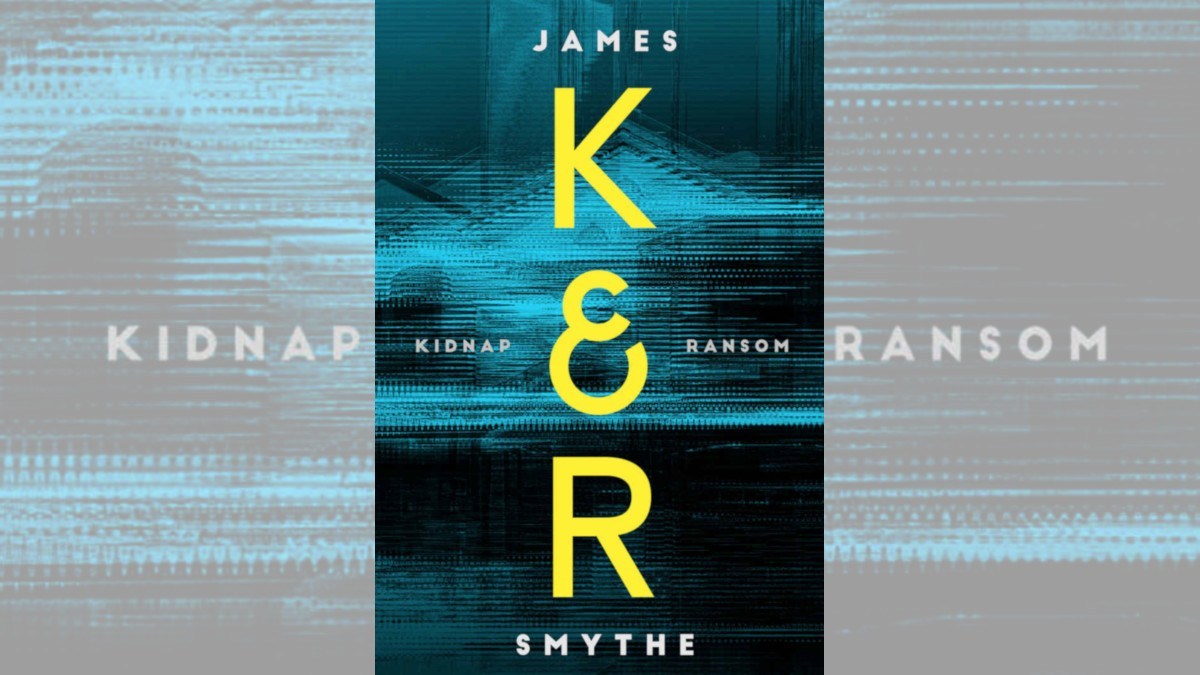Your days as a barista are over—now you’ve opened your own cafe, where you can decide what products to serve and what furnishings will attract the best customers. Build up your hype, get some good reviews, and Seize the Bean!
What Is Seize the Bean?
Seize the Bean is a coffee-inspired game from Quality Beast for 2 to 4 players, ages 10 and up, and takes about 45–90 minutes to play. It’s currently seeking funding on Kickstarter, with a pledge level of €39 (about $48) for a copy of the game. There is some complexity in the game that may make it challenging for less experienced gamers, but for the most part is thematically fine. There’s a lot of humor in the game in the types of customers that come through, but some of that may be lost on kids; parents may want to skim over the Kickstarter page (particularly the stretch goals) to see some of the types of customers, since some are less kid-friendly than others (like the “Stoner” or “Streaker,” for instance).
New to Kickstarter? Check out our crowdfunding primer, and visit our Kickstarter curated page for more projects we love.

Seize the Bean Components
Note: My review is based on a prototype copy, so it is subject to change and may not reflect final component quality. The component list may also change base on stretch goals, so check with the Kickstarter page for the most updated list.
- 150 Customer cards
- 16 Friends and Family cards (4 per player)
- 75 Product cards
- 75 Upgrade cards
- 4 Player Boards
- 150 Coffee Beans
- 30 Milk Cartons
- 25 Sugar Cubes
- Resource Scoop
- 8 Barista Meeples (2 per player)
- First Player token
- Next First Player token
- 95 Good/Bad Review tokens
- 24 Hype tokens
- 16 Cafe Award tokens
- 16 Customer Award tokens

Even in prototype form, Seize the Bean looks really great: the player boards look like cafes, the cards are colorful and varied, and the ingredients look delicious. The coffee beans, milk cartons, and sugar cubes in the prototype are 3D printed, so the final version won’t be exactly the same, but you’ll have to watch that nobody tries to pop a sugar cube in their mouth.

The prototype came with 6 sets of customers, but the campaign has already hit several stretch goals to add even more sets. Each time you play, you will mix together several sets (depending on the number of players), and so the additional customer types will give you even more variety. There are hipsters, musicians, tourists, cyclists, tech nerds, criminals, health nuts, and (of course) board game geeks, each with their own tastes and special effects. I like the diversity represented in the people; the characters are more like stereotypes or archetypes, but I feel like most of what I’ve seen is fun and not insulting.
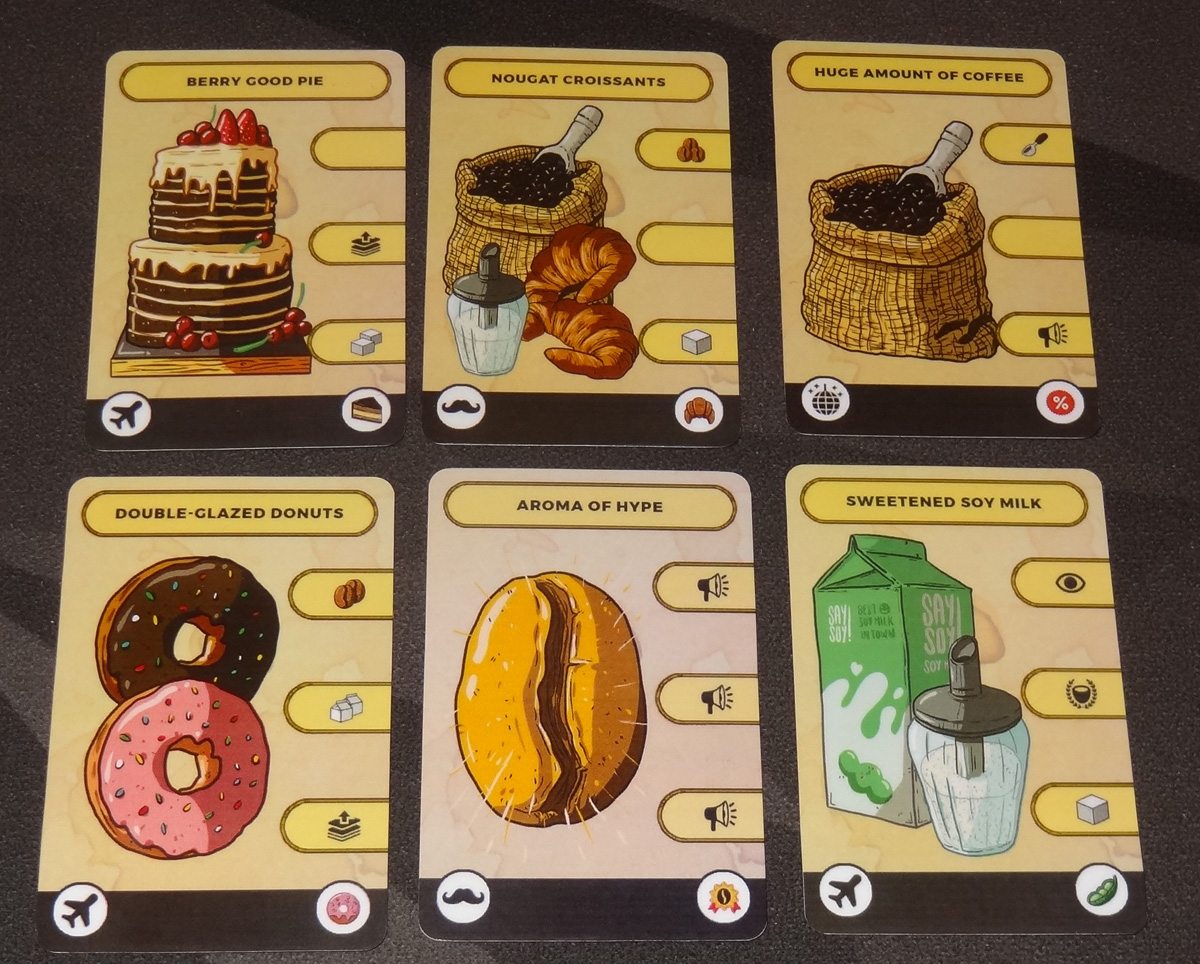
There are also a variety of special products you can add to your pantry, and the illustrations on these are also very fun: donuts, croissants, soy milk, premium coffee beans, and more. The upgrades for the cafes didn’t have fully completed art, but the variety of items is very fun (and often funny).
There’s a lot of iconography in the game, I think to reduce the amount of text explanations required. That means that as you’re learning the game, you’ll have to refer to the rulebook to remember all the different effects (because there are a lot of them), but after a couple plays they start to click. I think the icons are still undergoing some fine-tuning; it might be nice to have all the icons be a smidge larger, though, because they’re fairly small and I imagine could be difficult for some players to interpret.
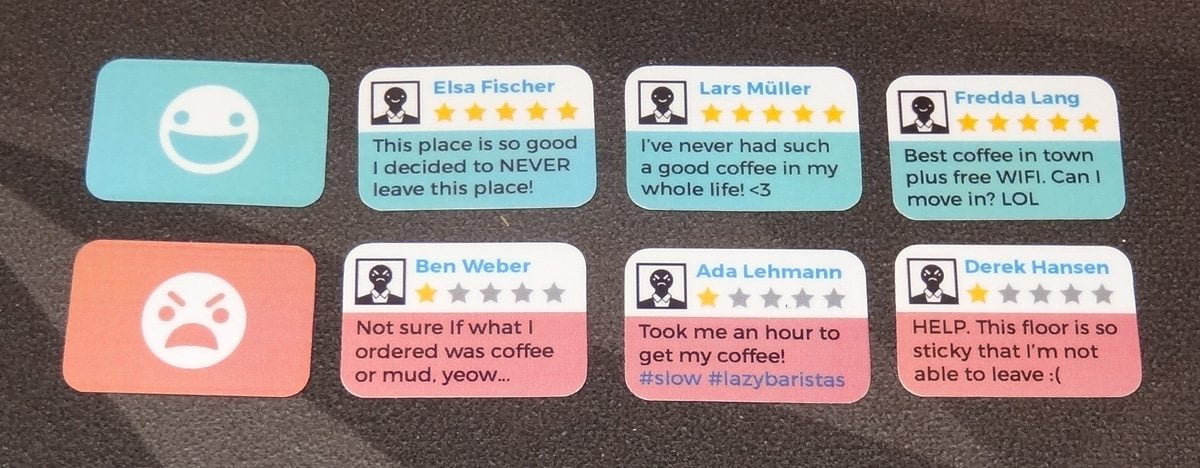
I also really liked the illustration style and the design sensibilities of the game. The good and bad reviews are made to look like little Yelp-style comments, and although there are only 3 of each in the prototype, the final version will have a lot more (submitted by backers at the higher pledge tiers).
Overall, I’m pleased with how the game looks, at least in prototype. The finished version should use cardboard tokens and boards instead of cardstock, and the card quality will be better, but I imagine the bulk of the game will look fairly similar to what you see in the photos. (The meeples will be standard-shaped meeples with barista aprons, rather than the otters shown in the photos.) I don’t know the finished size of the box or whether there will be a nice insert, though hopefully the publishers have considered a way to keep all the various customer types organized.
How to Play Seize the Bean
You can download a copy of the rulebook here.
The Goal
The goal of the game is to have the most good reviews (by serving customers, upgrading your cafe, and attracting customers).
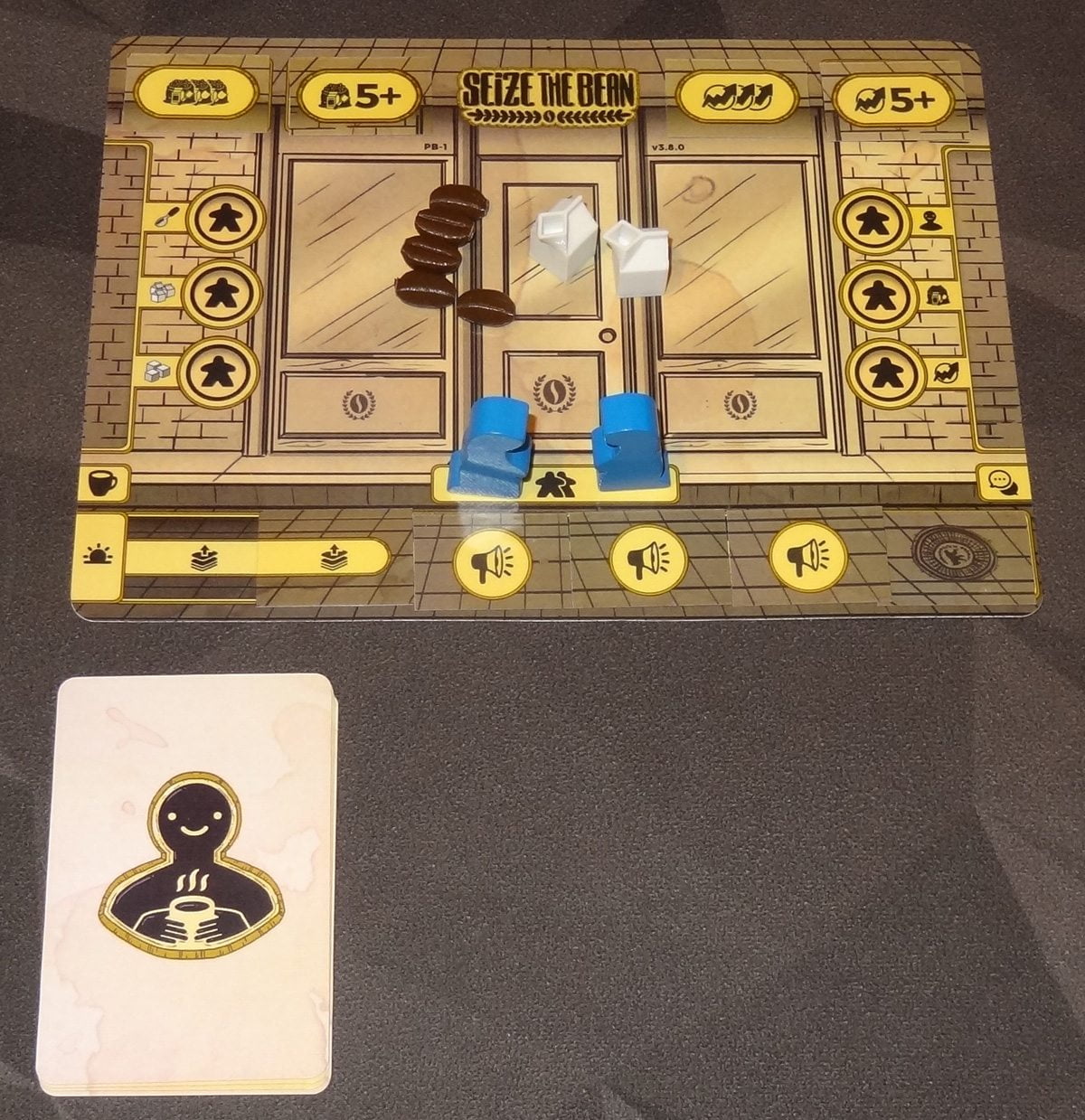
Setup
Each player gets a player board, four Friends and Family starting customer cards, two barista meeples, 5 coffee beans, and 1 milk. The board should also have four award tokens (point-side-down), plus four hype tokens and a maximum hype token. The hype tokens are placed on the hype track at the bottom so that there is 2 hype (you always have a minimum of 1 hype, so the one printed on the board is not covered by a token).
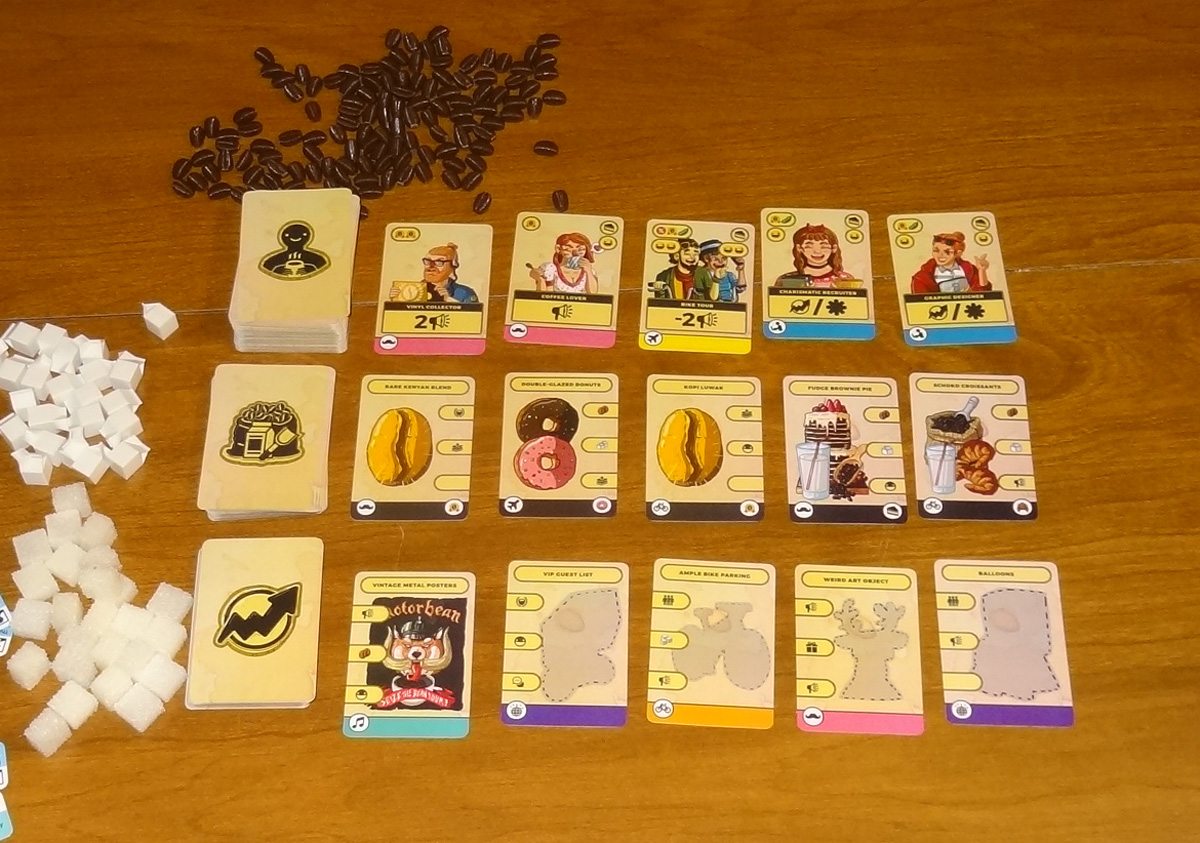
Build the three decks: customers, products, and upgrades. Each deck will use a number of sets based on the number of players, and you will use the same sets across the three decks. For instance, if you are including the cyclist customers, then you will also use the cyclist products and the cyclist upgrades. Shuffle each deck individually, set them in the center of the table, and reveal the top 5 cards of each deck in rows.

Choose a player to be first player and give them the first player token. Give the “next first player” token to the player to their left. (The reason there’s a “next first player” token is because some abilities allow you to take that token, changing the turn order for the next round.)
Count out a number of “good review” tokens based on the number of players, and set the rest aside. The good reviews serve as a timer, and the game end is triggered when they run out. Place the bad reviews and ingredients in piles within reach.
Gameplay
The game is played over a series of “days.” Each day consists of these phases—all players complete a phase in turn order before moving to the next phase.
- Serve customers. (Skipped on the first day.)
- Perform first action.
- Perform second action.
- Receive Word of Mouth.
- End of day cleanup. (Can be done by everyone simultaneously.)

Serve Customers
You must serve your customers from left to right, and you can’t skip any unless you don’t have the ingredients to serve them. (If the customer has a patience token on them, you may discard it to skip them.) The symbols at the top left show the customer’s primary order, which is required; the symbols at the top right (if any) show a bonus order that may result in bonus good reviews. At the bottom of the card is the customer’s effect, and at the very bottom is an icon showing you which set the customer is from.
The three ingredients you have to work with are coffee beans, milk, and sugar (which represents food items). The regular coffee bean icon and milk icons cost one bean and one milk, respectively. There are also other symbols for premium or discount beans and soy milk, which cost two each, but if you have that particular item in your pantry, then they cost one each (regardless of how many you have in your pantry). Food items are similar: they cost two sugar each, unless you have the matching item in your pantry.
In the photo above, I served the big family four beans (for the two discount bean icons) and four milk (for the two soy milk icons), and got two good reviews (for the two smiley faces). I chose not to serve them the extra snack because I wanted to save some sugar cubes for my other customers. The effect at the bottom is to reduce my hype by two.

If you cannot serve a customer, then other players (in turn order) have an opportunity to serve your customer as if in their lines, getting good reviews and customer effects. (In the advanced game, a customer who gets served by a different player goes to that player’s discard pile.) If nobody serves the customer, place an impatience token on them—this will turn into a bad review if you can’t get rid of it by the end of your turn.

Some customers (like the musicians) can give patience tokens when served. A patience token will first remove all impatience tokens from a customer and discard them, and then prevents that customer from becoming impatient as long as it is there.
Once you’ve made it to the end of your customer line, discard any customers that don’t have a patience or impatience token on them (putting the reviews on them into your scoring pile). Then, slide everyone to the left, and flip one patience/impatience token over to the review side. This customer will be in line the next day. If any customer has three bad reviews, the customer is removed from the game (and the bad reviews are put into your scoring pile).

Perform Actions
Each player will get two opportunities to take actions, shown on the player boards. You place your meeple on one of the action spaces, and then take that action. (Each action may only be taken once per round.)
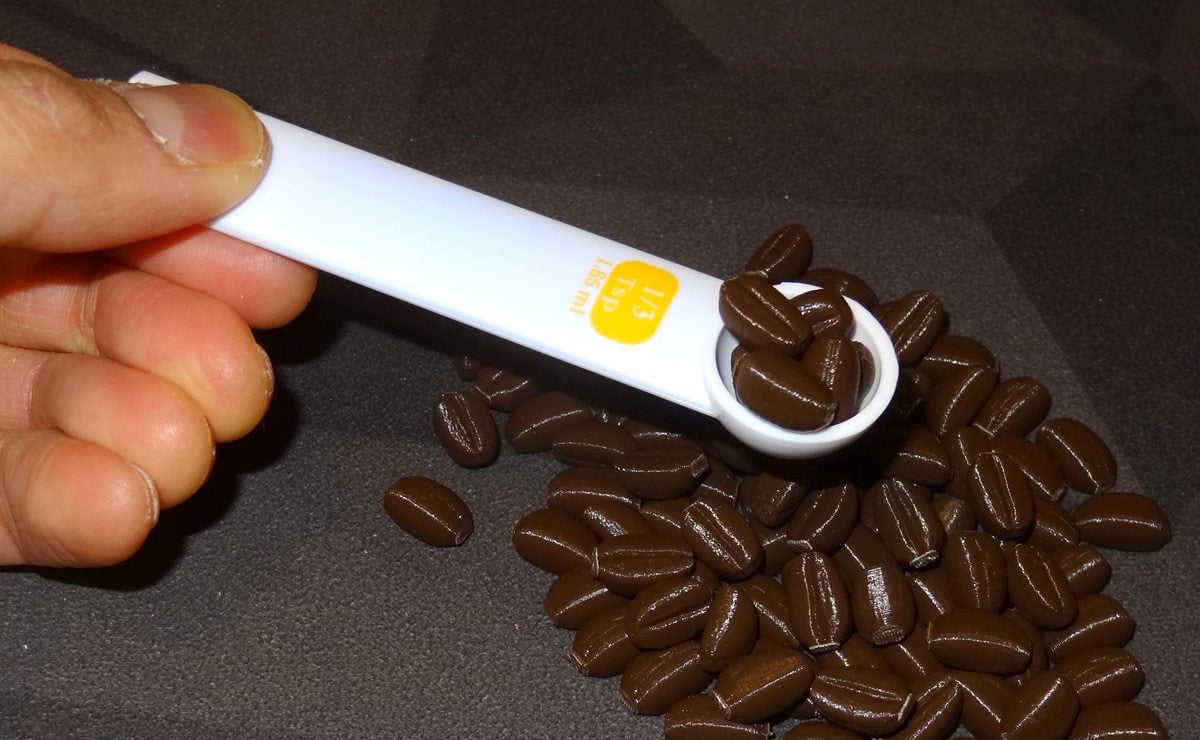
On the left, there are three actions to take ingredients: beans, milk, or sugar. You take the amount shown, and the “scoop” icon means that you get six beans. Or, if you want to play with the dexterity option, you actually scoop up beans with the spoon—anything that gets dropped before you make it back to your own area is forfeit.
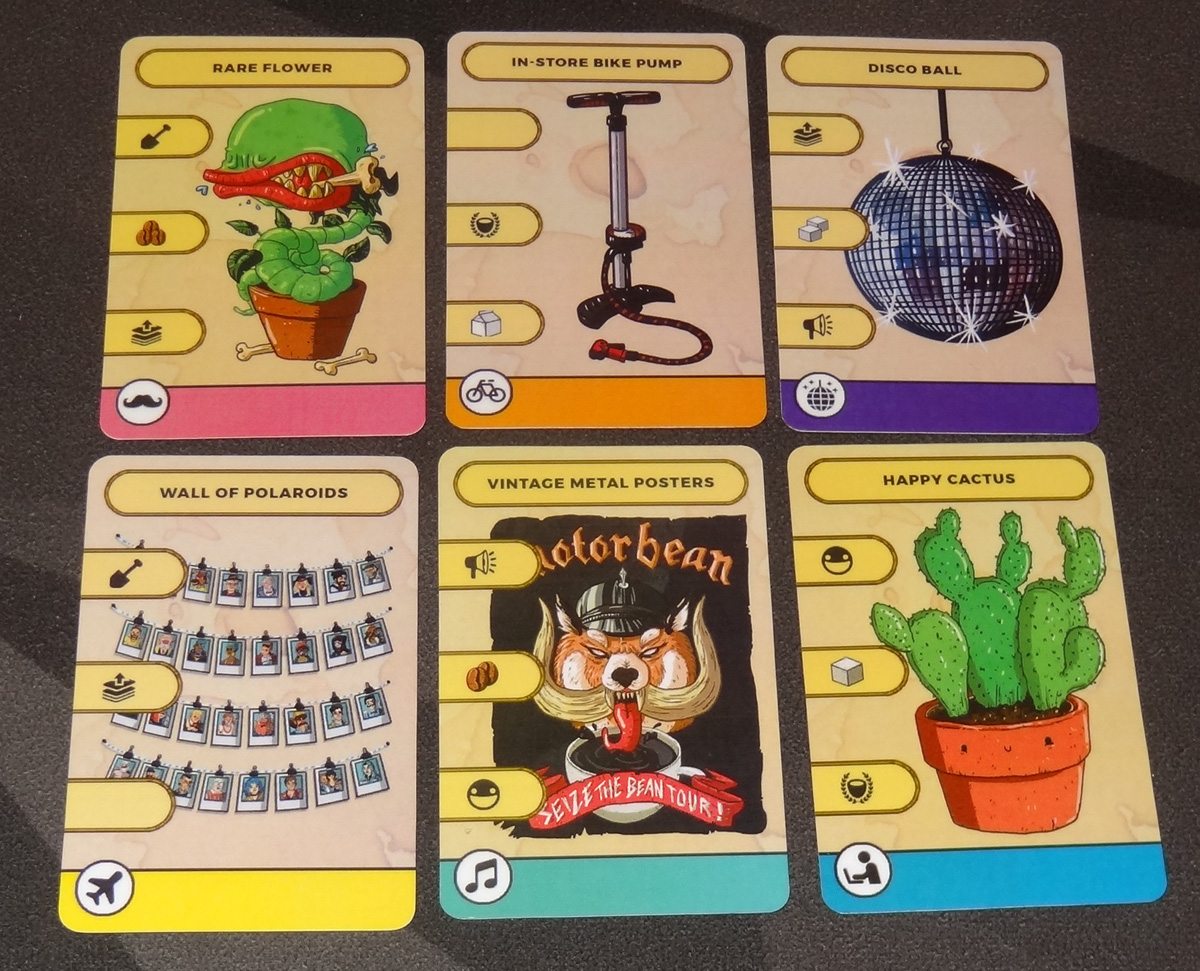
On the right, there are three “city actions” that allow you to take cards from the center supply: you can take a customer (which goes in your own discard pile), a product (which goes into the pantry on the left side of the board) or an upgrade (which goes into your upgrades section on the right side of your board). Customers will give you better effects when you serve them, products will make it easier for you to serve fancier coffee or better snacks, and upgrades will make your city actions more effective.

As you add products and upgrades to your cafe, the “ribbons” on those actions will gain more and more icons. Each time you take the associated action, you get to activate every icon in that ribbon. For instance, in the image above, if I take coffee beans (top), I get two additional beans and a good review. If I take milk, I’ll get six milk (instead of three) plus I get to peek at the top card of my customer deck and increase my hype. There are a variety of different bonuses that appear on the cards.
As cards are taken from the center supply, cards slide to the right immediately and are filled in from the deck on the left.
Word of Mouth
After everyone has taken two actions, you get “word of mouth” in turn order. Each player must take one customer from the center supply that matches one of the set icons currently showing in their player area—either the top product card or any of the upgrade cards. The customer is placed in their discard pile.

End of Day Cleanup
At the end of the day, advance all of the cards in the supply (customers, products, and upgrades) one space, stacking them onto the last column, and draw a new card for each row. Each player removes their meeples from their player boards. Each player draws a customer from their own deck for each hype they have. (If you don’t have enough customers in your deck, reshuffle your discard pile.) The newly drawn customers are placed in order, to the right of any customers that may still be there from the previous round.
Pass the first player token to the player who has the next first player token, and then give the next first player token to their left.
Game End
When the supply of good reviews runs out, the game end is triggered. (Continue awarding good reviews from the extras in the box.) Finish the current round. Then, play one more “Serve Customers” phase and then the game ends.
Scoring
Each good review is worth 1 point, and each bad review is worth -1 point.
At the top of your player board, there are four awards that are each worth 5 points if you have the following:
- 3 of the same type of products (e.g. 3 croissants)
- 5 different types of products
- 3 of the same type of upgrades (e.g. musicians)
- 5 different types of upgrades
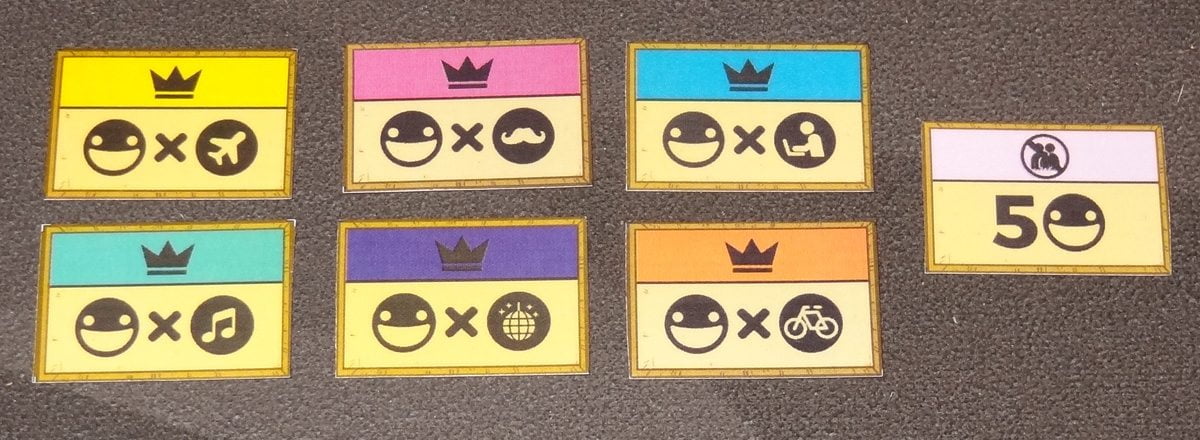
You also look at all of your customers and all of the set icons showing in your upgrades and your top product card. The player who has the most of each set gets that set bonus. So if you have the most cyclist upgrades and customers, you will get the cyclist bonus award, which is worth 1 point per cyclist symbol. If there are ties, nobody gets the award.
There is also a 5-point bonus award if a player managed to get rid of all of their friends and family cards, but only if they’re alone in doing so.
The highest score wins.
Why You Should Play Seize the Bean
Seize the Bean is a mixture of several different mechanics: a little bit of deck-building and engine-building, resource management, set collection, and card drafting. The Kickstarter description seems to imply that it’s primarily a deck-builder, but I feel like some of the other aspects of the game are just as important, giving it a unique flavor. Let’s dig in.

(Prototype shown) Photo: Jonathan H. Liu
The deck-building aspect refers to your customer deck: everyone starts with a basic set of friends and family: your popular friend, who brings new customers to the shop; your lazy friend, who wants coffee and will stick around forever; your Oma, who likes her coffee extra strong but will give you a good review; and your Grandpappy, who will kick somebody out of your shop if you want him to. They’re easy to serve, but you can’t run a successful cafe on friends and family. As you play, you will bring in new customers, who are more demanding but are also more rewarding: they may increase your hype, help you upgrade your cafe, or write even more good reviews. You gain customers by taking the “get customer” city action, and through the Word of Mouth effect. At the end of the game, your customers may help you win those set bonuses, but only if you have more of a set than the other players.
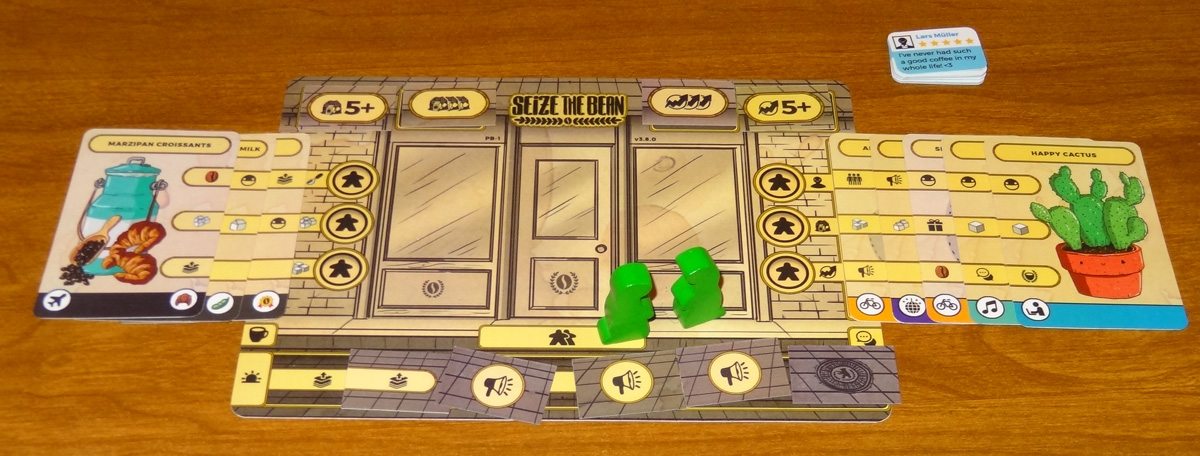
Another important aspect of the game is the tableau-building, where you add products and upgrades to your player board. This is where you build up an engine, so that every action you take is stronger. Unlike a deck-building game, the cards you put into your pantry and upgrades don’t get shuffled or cycled through. Products will help you serve customers with fewer resources, and get you more resources when you take those actions. Upgrades will give you lots of bonuses when you take customers, products, or upgrades. If you’re clever (and lucky), you can build powerful synergies. For instance, in the photo above, every time I take a new product (the center action on the right), not only do I get the new product card, I also get to take five sugar cubes, 2 milk, and trigger the “sample” bonus, which gives me one of the bonuses on my newest product card. If I keep using it, I might never need to spend an action taking resources.
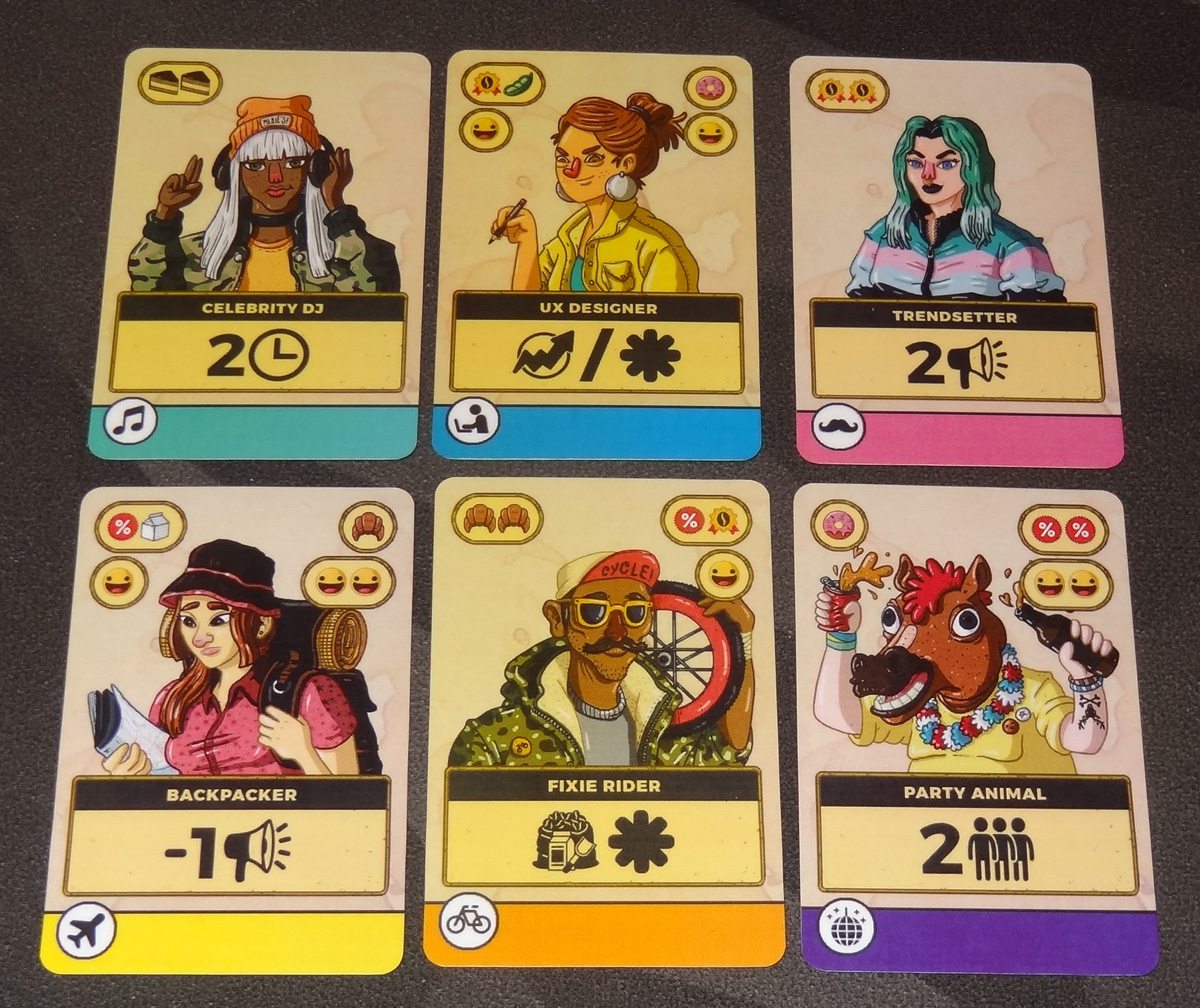
Some of the customer types really play off those abilities, too: the tech folks and cyclists will let you get new upgrades or products right when you serve them, and/or trigger those bonus ribbons—it’s effectively giving you an extra action during your “serve customers” phase. The party customers bring more customers into your line immediately—that can be a blessing or a curse, depending on whether you’ve got enough ingredients on hand. Tourists tend to give a lot of good reviews, but they decrease your hype. Knowing what your customers like so that you can look for those products is important; it’s also important to have the right upgrades so you can attract the customers that you want.

If you build up your engine just right, you can trigger huge chain reactions. In the photo above, I managed to serve ten customers in my last turn. I had some customers that let me trigger product or upgrade actions, getting me more ingredients. Then I served some customers that let me put more customers into my line, which added some customers that let me get more ingredients, and so on.
Seize the Bean is a game about running a business that doesn’t involve any money. Instead, your constraints are more about time, or number of actions. With only two actions per round, do you upgrade or get more coffee beans? Is it worth risking a customer’s patience to make your shop better for the future?

I also like the option to serve other players’ customers: if your shop is all out of donuts, then the customer buys one from mine, and I get the bonus. So far I haven’t played the advanced variant, where the customer permanently becomes mine after the transaction, but I really like that thematically: you’ve got one chance to give them what they want, and if they find it elsewhere, they’ll start patronizing that store instead… until it runs out of donuts. It adds some nice player interaction, because (as with many deck-building games) the primary interaction is taking cards from the center that you know somebody else wants.
Throughout it all, you have to figure out how to get points. You’ll need to get good reviews from serving customers, though some customers will only give good reviews for their bonus orders. You can also get points by maxing out your hype—every hype added after that gives you a good review, though you’ll have to figure out how to manage a big crowd every turn. And, of course, you want to keep in mind the end game bonuses: products and upgrades are both worth bonus points, and getting more cards of a set.
So far I’ve only played with the six sets shown in the photos above, but there are many, many more that have already been unlocked in the stretch goals, and I’m excited to see how they function and what new abilities they will bring with them. I can see that it could really change the feel of the game, because my engine-building would be drastically different without the tech and cyclist customers.
Seize the Bean can seem a little overwhelming at first, trying to decide what actions to take, what customers to attract, whether to upgrade your cafe or get a new product. I do like that the first two rounds are simplified somewhat because you know you have enough ingredients to serve your first four customers without having to take any resources—that lets you focus on the city actions at first. It can take a play before you really start to see how the various cards work together so you can start crafting a strategy, but once you’re familiar with the various actions and effects (and there are a lot of them), the game really starts to heat up.
I’m really glad I got a chance to try out Seize the Bean—I wasn’t sure it was going to be my cup of tea (so to speak) because I don’t really care about coffee myself. But take it from me: you don’t need to enjoy coffee to enjoy this game! I like the thematic ties on the customers, products, and upgrades, and there’s a lot of humor (some of it better for adults than kids). The game is maybe medium-weight in complexity; I did play with my 11-year-old, who picked up the rules and enjoyed it, but had trouble keeping up with the adults score-wise. The rules are somewhat involved, but working out the strategy is a bit tricky.
If you like the mix of deck-building and tableau-building, it’s definitely worth a look. For more information or to make a pledge, visit the Seize the Bean Kickstarter page!
Click here to see all our tabletop game reviews.
If you’d like to stay up-to-date with all of our tabletop gaming coverage, please copy this link and add it to your RSS reader.
Disclosure: GeekDad received a copy of this game for review purposes.






